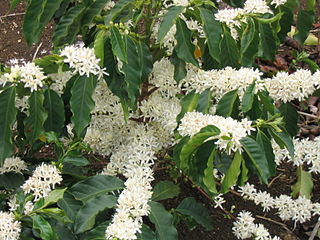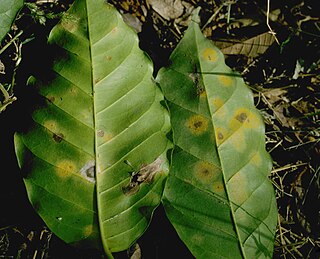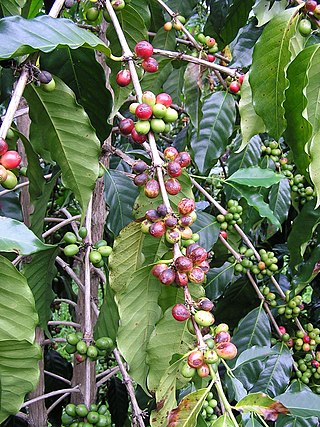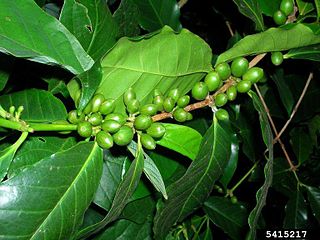This article includes a list of references, related reading, or external links, but its sources remain unclear because it lacks inline citations .(July 2014) |
This article is a list of diseases of coffee (Coffea arabica, Coffea canephora).
This article includes a list of references, related reading, or external links, but its sources remain unclear because it lacks inline citations .(July 2014) |
This article is a list of diseases of coffee (Coffea arabica, Coffea canephora).
| Nematodes, parasitic | |
|---|---|
| Root knot | Meloidogyne spp. |
| Viral diseases | |
|---|---|
| Coffee Ringspot Virus (CoRSV) | Virus Dichorhavirus |
| Miscellaneous diseases and disorders | |
|---|---|
| Hot and cold disease | Physiologic effect of exposure to extremes of temperature – common at high altitudes |
| Physiological effect of overbearing | Often exacerbated by rust |

Coffea is a genus of flowering plants in the family Rubiaceae. Coffea species are shrubs or small trees native to tropical and southern Africa and tropical Asia. The seeds of some species, called coffee beans, are used to flavor various beverages and products. The fruits, like the seeds, contain a large amount of caffeine, and have a distinct sweet taste.

Coffea arabica, also known as the Arabic coffee, is a species of flowering plant in the coffee and madder family Rubiaceae. It is believed to be the first species of coffee to have been cultivated and is currently the dominant cultivar, representing about 60% of global production. Coffee produced from the less acidic, more bitter, and more highly caffeinated robusta bean makes up most of the remaining coffee production. the natural population of Coffea Arabica are restricted to the forests of South Ethiopia. Coffea arabica is called بُنّ in Arabic.

Coffea canephora is a species of coffee that has its origins in central and western sub-Saharan Africa. It is a species of flowering plant in the family Rubiaceae. Though widely known as Coffea robusta, the plant is scientifically identified as Coffea canephora, which has two main varieties, robusta and nganda.
Leucoptera caffeina is a species of moth. This leaf miner is one of several related pests on Coffea species. It is found in Angola, Zaire, Kenya and Tanzania in Africa. Other coffee leafminers include Leucoptera coffeella.

Hemileia vastatrix is a multicellular basidiomycete fungus of the order Pucciniales that causes coffee leaf rust (CLR), a disease affecting the coffee plant. Coffee serves as the obligate host of coffee rust, that is, the rust must have access to and come into physical contact with coffee in order to survive.

Mycosphaerella coffeicola is a sexually reproducing fungal plant pathogen. It is most commonly referred to as the asexual organism Cercospora coffeicola.

Colletotrichum kahawae is a fungal plant pathogen that causes coffee berry disease (CBD) on Coffea arabica crops. The pathogen is an ascomycete that reproduces asexually. The asexual spores (conidia) are stored within acervuli. This disease is considered to be one of the major factors hampering C.arabica production in the African continent, which represents the current geographic range of the fungus. Coffee berry disease causes dark necrosis in spots and causes the green berries of the coffee to drop prematurely. High humidity, relatively warm temperatures, and high altitude are ideal for disease formation. Given the severity of the disease and the lack of effective control measures, there is great concern that the fungus may spread to other coffee producing continents, such as South America, which could have catastrophic consequences.
Gibberella xylarioides is a species of fungus in the family Nectriaceae. It is the causative agent of coffee wilt disease (CWD). The disease caused a severe problem in several countries in West and East Africa during the 1940s and 1950s. CWD was first seen in Coffea liberica.

Coffea liberica, commonly known as the Liberian coffee, is a species of flowering plant in the family Rubiaceae from which coffee is produced. It is native to western and central Africa from Liberia to Uganda and Angola, and has become naturalised in the Philippines, Indonesia, Seychelles, the Andaman & Nicobar Islands, and Malaysia.
Coffea charrieriana, also known as Charrier coffee, is a species of flowering plant from the Coffea genus. It is a caffeine-free coffee plant endemic to Cameroon in Central Africa. It is the first recorded caffeine-free Coffea in Central Africa, and the second to be recorded in Africa. The first caffeine-free species was previously discovered in Kenya, named C. pseudozanguebariae. The International Institute for Species Exploration at Arizona State University and a committee of taxonomists and scientists voted the C. charrieriana as one of the top 10 species described in 2008.

Low caffeine coffee is a term that is used by coffee producers to describe coffee that has not been subjected to a process of decaffeination, but is substantially lower in caffeine than average coffee. Samples of coffee vary widely in caffeine levels due to many factors, some well documented and some not fully understood, such as the action of soil, water levels and sunlight. Low caffeine coffees are typically created by assaying caffeine levels of different bean lots and selecting the best flavor profile from the lots that are naturally lowest in caffeine.
The Guadeloupe Bonifieur is a variety of coffee grown in Guadeloupe. Guadeloupe Bonifieur is the ancestor of Jamaican Blue Mountain Coffee and is very rare. The fresh air, high altitude, and abundance of rain create ideal conditions for growing this Arabica variety. The variety is called Guadeloupe Bonifieur because of its high quality and great taste, and because, in the past, it was used to enhance lower quality blends. Connoisseurs consider it one of the best coffees in the world, even though it is only available from a few distributors.
Leucoptera coffeella is a moth in the family Lyonetiidae. It is found in every coffee-growing country in South America, Central America and the West Indies. It is considered one of the worst pest species of coffee.
Leucoptera meyricki is a moth in the Lyonetiidae family that is found in Ivory Coast, Angola, Congo, East Africa, Ethiopia and Madagascar. It was also discovered in Kenya and Tanzania. It is considered one of the worst pest species on coffee.
Leucoptera coma is a moth in the family Lyonetiidae. It is found in Zaire and Uganda. It is considered a pest species on coffee.

Coffea stenophylla, also known as highland coffee or Sierra Leone coffee, is a species of Coffea originating from West Africa.
Colletotrichum coffeanum is a species of fungal plant pathogen affecting mainly the species Coffea arabica and occasionally other species of the genus Coffea. Upon infection, the pathogen can cause coffee berry disease (CBD) which is also known as Brown Blight when it occurs on younger fruits still green in color. The fungus was first reported in Kenya in 1922, and is found throughout most of Africa. C. coffeanum is only found in Africa, but other species of Colletotrichum can be found throughout the rest of the world.
Coffee wilt disease (tracheomycosis) is a common wilt that results in complete death of coffee trees it infects. This vascular disease is induced by the fungal pathogen known by its teleomorph Gibberella xylarioides. In 1927, coffee wilt disease (CWD) was first observed in the Central African Republic where it developed slowly and went on to cause two epidemics between the 1930s and the 1960s. Coffee wilt disease was first seen in Coffea excelsa.

Coffea racemosa, also known as racemosa coffee and Inhambane coffee, is a species of flowering plant in the family Rubiaceae. It has naturally low levels of caffeine, less than half of that found in Coffea arabica, and a quarter of that in Robusta coffee. It is endemic to the coastal forest belt between northern KwaZulu-Natal in South Africa and Zimbabwe, found in an area less than 150 km2 (58 sq mi) in size. It was widely cultivated by the Portuguese during the 1960-1970s in Mozambique, currently there are only two plantations at Ibo Island and in Hluhluwe, which remain.